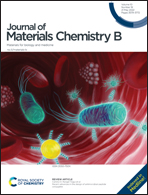Cross-linker-free sodium alginate and gelatin hydrogels: a multiscale biomaterial design framework†
Abstract
Surface functionalization and cross-linking have been adopted extensively by researchers to customize hydrogel properties, especially in the last decade. The clinical translation of such biomaterials is in a poor state due to long-term toxicity, often beyond the periphery of the short-term animal studies. We endeavor to relook at the material development strategy with all FDA-approved biopolymers in their native states, like gelatin and sodium alginate, without using any functionalization and cross-linking. The fabrication of a cross-linker-free hydrogel has remained one of the main challenges in biomaterial design and requires multiscale structuring of the hydrogels. The physical properties of these hydrogels were enhanced by plasticizers (PEG and glycerol) and a monovalent salt (NaCl). An in-depth analysis suggested that PEG forms a plasticizing layer at the sodium alginate and gelatin interface and glycerol alters the overall polymer structure. The results were further complemented by different characterization methods (scattering techniques and infrared spectroscopy) and molecular dynamics simulations. The detailed microstructural analysis surfaced the enthralling integrated swelling mechanism in gelatin chains that led to high-performing hydrogels.



 Please wait while we load your content...
Please wait while we load your content...